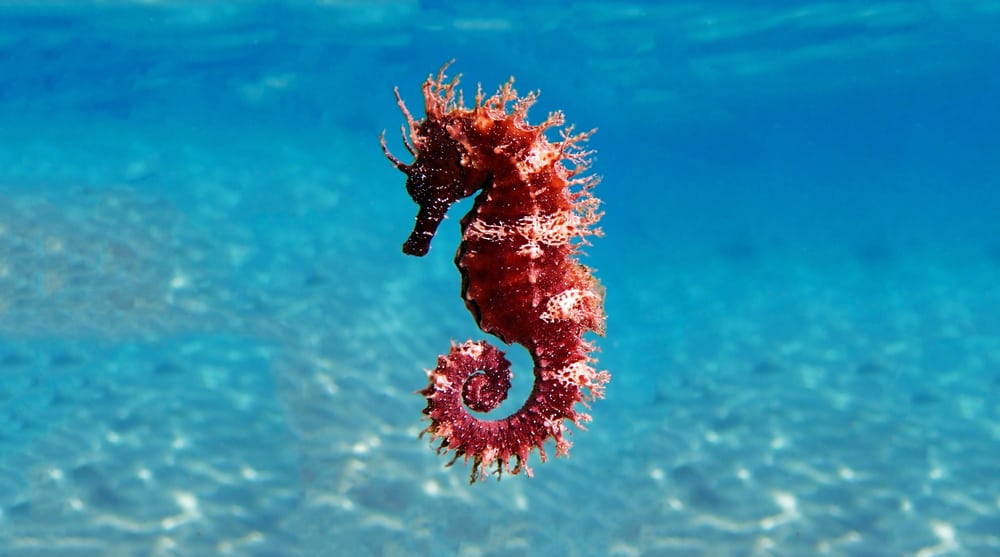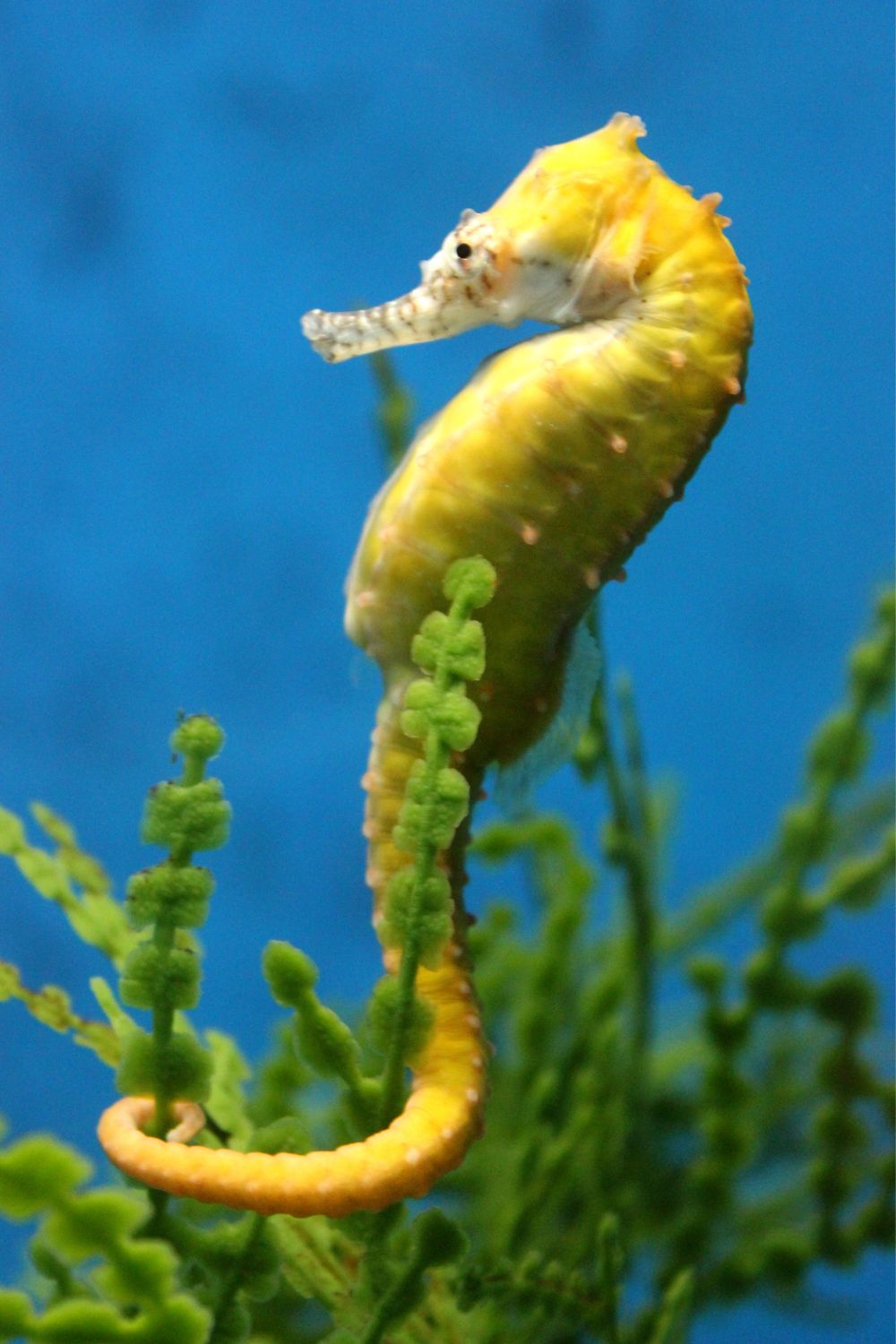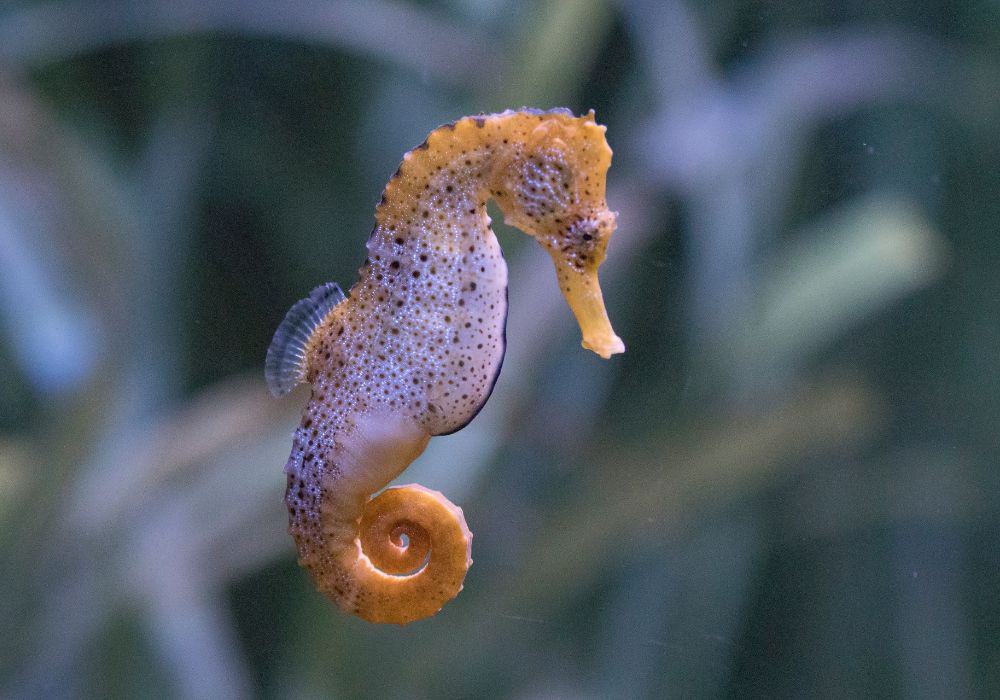Seahorses are small types of fish that live near the bottom of the ocean. They have a distinct body shape and are instantly recognizable. They are also some of the most peculiar marine animals with several unique characteristics.
While the diet of seahorses is limited, it’s still important to learn about it because seahorses are essential parts of many food chains. So, what do seahorses eat? And which animals are their predators? We’ve got the answers you need!
In this article, we’ll check out some cool facts about seahorses regarding their diet and biology. We’ll also find out what the feeding habits of this cute little marine animal are, and what fish prey on it.
Facts About Seahorses
Seahorse is the name of a family of 46 small fish species that all belong to the genus Hippocampus. The word “hippocampus” originates from Ancient Greek and is the combination of the words for “horse” and “sea monster”.
Seahorses generally prefer warmer tropical waters with shallow depths. You can find them in ocean waters throughout the Pacific and the Atlantic Ocean, as well as some European waters such as the Mediterranean Sea. They usually live in areas with shelters like seagrass beds and coral reefs.
While seahorses are considered fish, they have very different characteristics compared to traditional fish. They do not have scales but only a layer of thin skin over their bones which are arranged in ring formations. Each unique seahorse species has evolved to have a specific number of these rings.
Seahorses have a very special mating process that’s different from almost all other animals on the planet. The most significant difference is that the male seahorse is the one that carries the eggs until the young seahorses are born and are ready to be released.
Before the mating process even starts, the two seahorse partners perform extensive courtship for many days. This is to ensure that both their reproduction cycles are synchronized and that the male is ready to carry the eggs that the female will deposit. This flirting often includes a dance in which the two seahorses wheel around together.
When the mating process starts, the male seahorse shows its empty egg pouch to the female seahorse. The female then deposits its eggs in the brood pouch for the male to carry. The whole process lasts about six minutes. Then the female leaves and comes back to visit the male the following day.
The male carries the eggs for 9 to 45 days until the seahorses have developed fully. Then, the male releases the young seahorses, leaving them to fend for themselves. Since they are very small, they are particularly prone to predators, and only very few survive. That’s why during each mating session, a female can deposit up to 1,500 eggs inside the male during each mating session.
What Do Seahorses Eat?
Seahorses belong close to the bottom of most food chains. Due to their small size, they can only eat prey that’s much smaller in size, so it can fit in its long snout. Also, since seahorses are not very potent swimmers and have a rudimentary digestive system, they can only devour small and simple life forms.
The diet of seahorses primarily consists of different kinds of plankton. Although they can consume species of phytoplankton, their preference is towards zooplankton species, especially small crustaceans.
Some of the seahorse’s favorite species to eat are copepods, krill, and small shrimps like the Mysis shrimp, also known as opossum shrimp. Seahorses have also been spotted consuming other small invertebrates and fish larvae. Here’s a list of some of the most common foods that seahorses eat:
- Amphipods
- Copepods
- Decapods
- Krill
- Rotifers
- Mysis shrimp
- Sea snails
- Ghost shrimp
- Larval fishes
- Grass shrimps
- Brine shrimp
- Phytoplankton
- Algae
What Do Young Seahorses Eat?
When the male seahorse releases its babies in the water, the young seahorses need to survive the harsh conditions of the oceans until they grow in size. Thankfully, the father ensures that the younglings are released to a place where there’s an ample amount of food.
Still, young seahorses are very small and can often get carried away from the feeding grounds by ocean currents. Naturally, there’s also the threat of countless predators. Nevertheless, the small number of seahorses that survive these early stages follow a similar diet to adult seahorses.
Just like their parents, young seahorses primarily feed on different forms of zooplankton. However, since they are very miniscule, they can only eat tiny crustaceans like small copepods, rotifers, and certain shrimp species.
What Do Seahorses Eat In Captivity?
Seahorses are very common in many aquariums. However, they need to be kept in separate tanks with the right salinity in the water, with ample food and proper shelter from predators.
Recently, there has been an initiative to collect different species of wild seahorses and breed them in captivity to save the endangered ones. Many seahorses face extinction, partially due to the damage to coral reefs, which are the seahorse’s most common natural habitat.
The biggest issue with breeding seahorses in captivity is that young seahorses prefer live food rather than frozen food. Some breeders mix frozen and fresh crustaceans, whereas others follow a diet that consists of only fresh food for proper nutrition.
How Do Seahorses Get Their Food?
Seahorses are very poor swimmers and cannot catch their prey while swimming. Instead, they utilize a very unique pivot-feeding system. In fact, their horse-shaped body is believed to have evolved this way to help them with their feeding process.
The seahorse anchors itself to a piece of seaweed or coral using its prehensile tail. It camouflages itself and waits patiently until its prey comes very close to it. Once the prey is within reach, the seahorse uses its long neck to close the distance without getting noticed.
When it successfully approaches its prey, it suddenly thrusts its body upwards and quickly rotates its head around so its snout can reach the prey. They need to do this because their suction mechanism only works in close proximity.
The final phase of the seahorse’s feeding system is the recovery phase. During the recovery process, the seahorse’s body returns to its original position and rests for a bit before repeating the process.
The way the seahorse hunt can change drastically based on its environment. If it lives in an open area with little vegetation, the seahorse will anchor itself and wait patiently for its prey. However, if its habitat is filled with vegetation, it prefers to search its environment and feed while it swims.
In contrast, seahorses in captivity have been observed to thoroughly inspect their environment despite the low vegetation.
How Often and How Much Do Seahorses Eat?
Since seahorses are very small creatures, no more than 14 inches in size, you would expect them to require very little food. While seahorses do consume tiny quantities of food each time they eat, they need to eat an enormous number of times every day.
This is because their digestive system is very simplistic and processes foods very quickly with little energy gain. Also, seahorses don’t have teeth to chew food or a stomach to store large amounts of it. Therefore, they need to constantly eat in order to maintain their energy levels.
Adult seahorses are always looking for food and can eat up to 50 times a day. Baby seahorses eat an even larger quantity since they need it for their growth. Some young seahorses can eat more than 3,000 pieces of food every day.
 What Are Seahorses’ Predators?
What Are Seahorses’ Predators?
Seahorses are very vulnerable to predators due to their small size and their limited swimming capabilities. They also lack proper protection, except for the armor on their bony plates. Nevertheless, seahorses have their camouflage as a defensive mechanism to help them survive against predators.
Seahorses usually live in areas with thick vegetation that are sheltered from most large fish. Additionally, seahorses have evolved to have specific colors to match their surroundings. With this camouflaging ability, they can easily escape big predators that rely on sight to hunt.
Most seahorses are killed at a very young age since they can’t survive in the harsh environment of oceans. Those that survive and reach their adult stage are still not safe from predators. Some of the most common fish and animals that prey on seahorses are:
Humans are also responsible at large for reducing the population of seahorses through fishing nets, water pollution, and the destruction of coral reefs. Also, in some parts of the world, seahorses are harvested for food, medicinal purposes, and jewelry making.
Conclusion
Seahorses are very unique marine animals. They have one of the most unusual breeding processes and a distinct feeding system that allows them to suck their prey. Despite their small size, they need to feed constantly to maintain their energy levels.
Seahorses are also in danger of extinction, partially due to human activities. If these activities don’t stop, the world may soon be rid of these unique and fascinating creatures.


 What Are Seahorses’ Predators?
What Are Seahorses’ Predators?